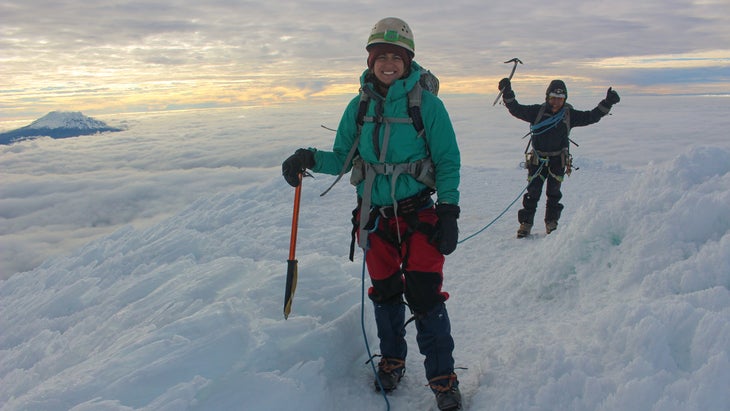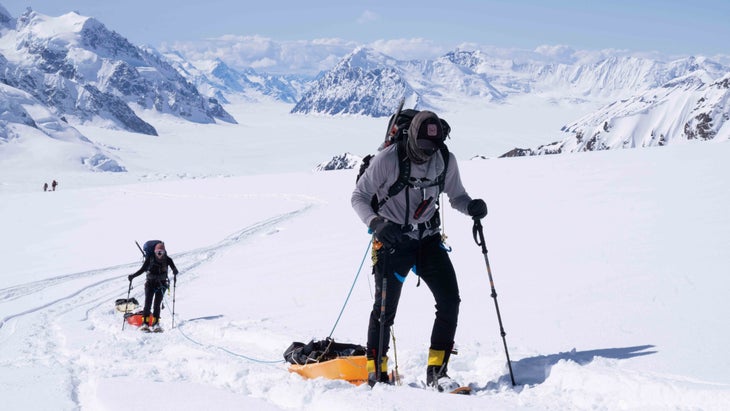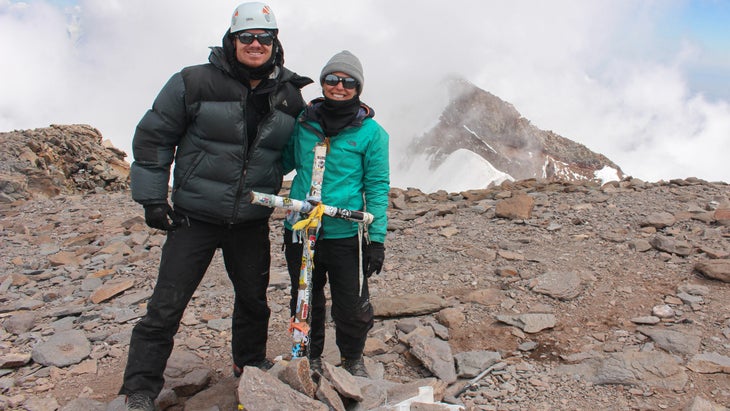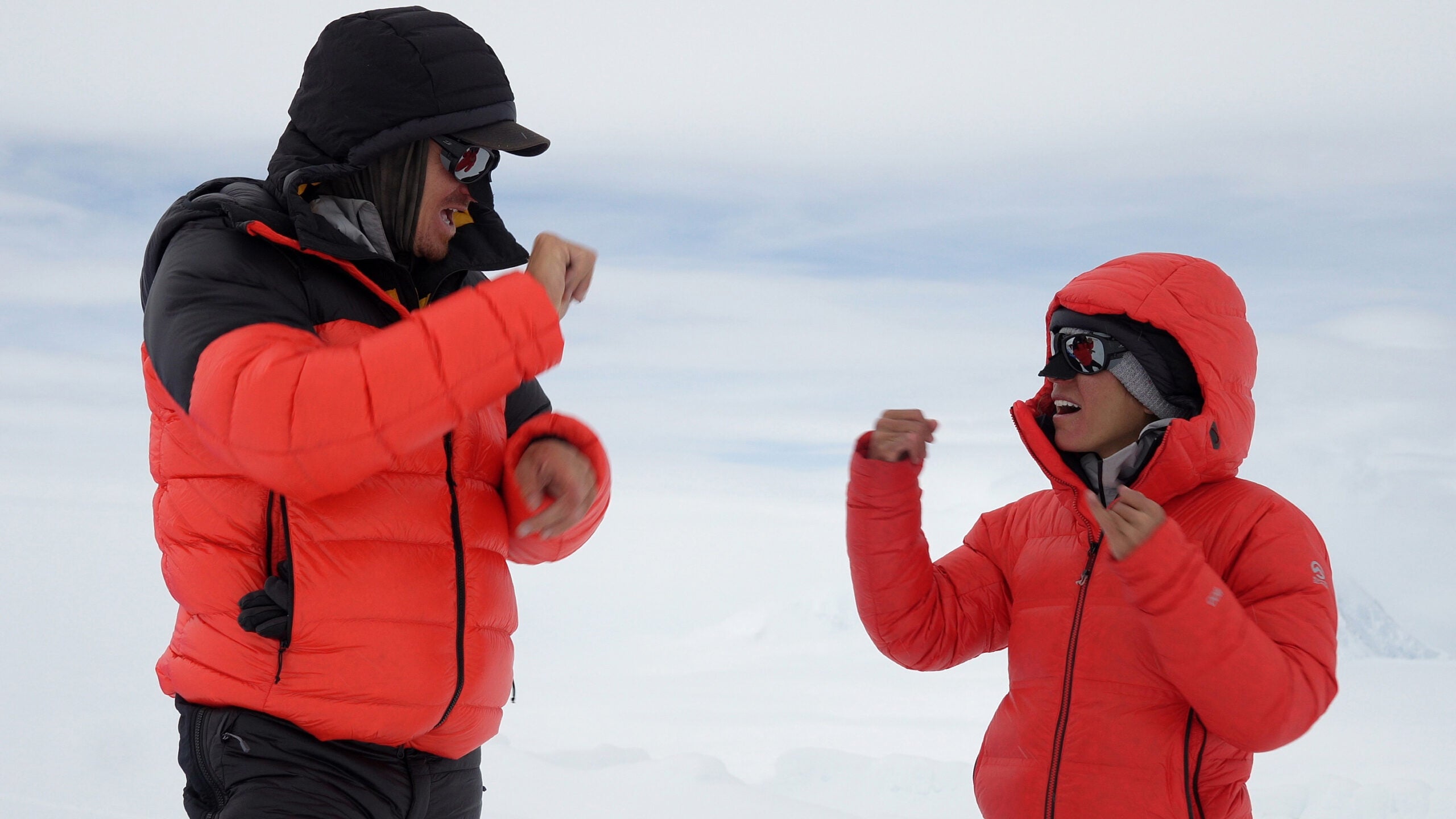During their 2018 ascent of ArgentinaтАЩs 22,837-foot Aconcagua, climbers Scott Lehmann, 33, and Shayna Unger, 30, carried pads of paper and pens in their pockets. As they stayed at Camp 2 at 18,000 feet and awaited good weather, the two wrote down questions on the pad about the forecast and about route conditions, and then showed their written inquiries to other climbers they met. It was a cumbersome means of communication, but it was the best way for Lehmann and Unger to obtain the information, since both climbers are deaf.
Other climbers proved to be unhelpful and indecisive in answering their inquiriesтАФLehmann and Unger believe the climbers didnтАЩt want to be responsible for their safety on the peak. So, the two tried a different strategy. They awoke one morning at 4 A.M., unzipped the flap of their tent, and stared out into the darkness to see if other teams were preparing to push for the summit. Every few hours, they peeked their heads out of the tent, searching the camp for headlamps. Eventually, after two nights of staring into the dark pre-dawn sky, Lehmann and Unger saw lights flickering in a neighboring tent and then climbers emerging to move up the mountain. They knew it was time to climb.

тАЬIt was tough,тАЭ Lehmann told ╣·▓·│╘╣╧║┌┴╧ using American Sign Language (ASL). тАЬWe didnтАЩt have the opportunity to make our own decision. We had to rely on making assumptions.тАЭ
Deafness presents a multitude of challenges in the high mountains, and in the decade that Lehmann and Unger have pursued mountaineering, they have developed creative ways to overcome the disability. They have been in a relationship since they were in high school, and both climbersтАЩ primary mode of communication is ASL; neither can converse with spoken language. The lack of spoken language-based communication creates additional risks; they cannot shout for the otherтАЩs attention in a fall, or communicate efficiently with hearing climbers if they are having a medical emergency.
Despite these hurdles, they have built impressive climbing resumes. The pair has climbed the highest points of three continents: Kilimanjaro, Aconcagua, and Denali, as well as numerous other notable peaks across the globe, such as EcuadorтАЩs Chimborazo and Cotopaxi, and FranceтАЩs Mont Blanc.
As children, neither Lehmann nor Unger, who met as high school students at the Maryland School for the Deaf and began dating after, envisioned a life on high peaks, in part because they lacked deaf role models who climbed.
тАЬIn our own deaf community, there werenтАЩt many deaf people who climbed mountains,тАЭ Lehmann said. тАЬThere was no representation.тАЭ
Lehmann first tried mountaineering at age 22 in 2012, during a road trip across the U.S. with two college buddies. They tried and failed to summit Mt. Rainier in Washington, but the failed summit attempt left Lehmann hooked on climbing. He wanted Unger to join him on a climb, but she needed some coaxing. She eventually joined him on Kilimanjaro in 2015.╠¤After the climb, she, too, was hooked.
тАЬYou canтАЩt beat the experience of climbing a mountain,тАЭ Unger said. тАЬEvery time we go on an expedition, we immerse ourselves into nature. ItтАЩs just us and the mountain. We get beautiful views that we wouldnтАЩt see in our regular everyday lives.тАЭ
Though they both know ASL, Lehmann and Unger use gestures to communicate with each other on a mountain. Identifying the small hand movements of ASL is difficult on a mountain, especially when they are far apart. In such situations, they transition to basic gestures. To indicate тАЬstop,тАЭ they will make a big тАЬXтАЭ with their arms. To tell the other to тАЬslow downтАЭ they will wave their arms up above their head and down to their waist.

They also set rules on how to get each otherтАЩs attention. When they are roped up, they simply tug on their rope three times. If theyтАЩre not roped up, the person in front will look back every one or two minutes to ensure that the other is safe and to see if they have anything to communicate.
Lehmann and Unger prefer to climb without a guide. With each other, there is no communication barrier; they both know and trust their system of gestures and rules. But they had no choice when climbing EcuadorтАЩs 19,347-foot Cotopaxi and 20,549-foot Chimborazo in 2018.
Upon learning that they were deaf during their first in-person meeting, the guide they hired was dumbfounded.
тАЬHis eyes went wide,тАЭ Unger said. тАЬWe could tell his mind was churning, thinking of how he could communicate with us.тАЭ
Lehmann and Unger had come prepared. They had downloaded an English-Spanish translation app on their phones to make initial communication easier. Then, they taught the guide some of the gestures they used on mountains.
On Cotopaxi, the guide looked back in bewilderment the first time Unger tugged on the rope to get his attention. She had wanted the guide to adjust their pace, so she waved her arms up and down and made a thumbs down gesture. The guide stared at her in confusion and she mouthed the words тАШslow downтАЩ until the guide finally understood. They summited, but the climb hadnтАЩt felt smooth; they werenтАЩt on the same page with the guide yet.
After one nightтАЩs sleep in between climbs, they started up on Chimborazo. Quickly, they noticed that the guide was becoming more comfortable communicating with them. They fell into an easy rhythm and reached the top without any issues.
Afterward, the guide admitted to Lehmann and Unger that he could barely sleep the night before they started climbing, worrying about communication and safety. The deaf climbers had proven that he neednтАЩt have worried.
тАЬHe told us that we climbed as well as anyone else heтАЩd guided,тАЭ Unger said. тАЬWe just communicated with him differently from them.тАЭ
For a 2021 expedition on Denali, they spent months meticulously reviewing each section of the climb. Along the West Buttress route, they identified an exposed stretch between the 9,600 foot camp and the Denali Base Camp called Windy Corner. As climbers rounded the Corner, their sleds, carrying their equipment, would slide down in the direction of a crevasse-pocked glacier field, its weight and momentum pulling the climbers downward. It was important for Lehmann, Unger, and UngerтАЩs brother Chad, the third member of their all-deaf Denali climbing team, to stay focused and maintain their balance during this critical stretch.

They decided on two temporary tweaks of their communication system for Windy Corner. One was that they would not tug on the rope to get anyone elseтАЩs attention. A tug might be mistaken for the expected pull from a sledтАЩs slide and the confusion could increase the danger to them. The second tweak was that the climber in front was to glance back far more frequently than normalтАУevery fifteen to thirty seconds, instead of one to two minutes. If they were behind the others and needed to stop, they were to raise their hand to get the other climbersтАЩ attention.
The special rules worked and they cleared Windy Corner on June 5th. Eight days later, on June 13th, they became the first deaf-led expedition to summit Denali.
тАЬBefore every climb, we study the route until we know it by heart,тАЭ Scott said. тАЬWe might do twice the preparation work of some other climbers, but we do it to ensure that we climb safely.тАЭ
Last spring, Lehmann and Unger announced that they are aiming to become the first deaf climbers to complete the Seven Summits. They named their Seven Summits project тАШSeeing Beyond,тАЩ alluding to their broader goals of changing perceptions of deaf people and improving accessibility and inclusion in the sport of mountaineering.
тАЬWe hope to inspire other deaf people to pursue their dreams,тАЭ Scott said.
To them, setting this goal is a testament to the long journey theyтАЩve followed to arrive at this point. The goal is ambitious and their odds of success may be long; only 460 people have accomplished the feat.
But there are some things that they know that they can count on. They will show up at every mountain knowing the route by heart. They will have a plan for every dangerous section of climbing. And, as always, they will have pens and pads of paper in their climbing packs.


